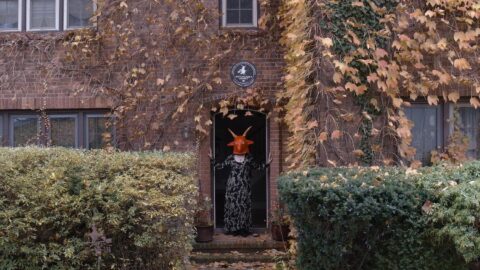At the Q&A for his film Realm of Satan (2024), director Scott Cummings said to the Sundance crowd that he and his cast treat the word Satan “in terms of magic.” He did not want to observe the Christian notions of the figure and its divisiveness. His impartiality about the religion led to a collaboration with the 50-year-old Church of Satan for his feature debut. Like his short Buffalo Juggalos (2014), the film pertains to the featured subculture members’ daily routines. Between the ordinary (a person watering plants in their garden and a couple having a drink) and the peculiar (a goat’s birth, gimps performing sexual acts in a studio, and a magician performing card tricks and sawing a performer in half) we witness the magical qualities of their everyday lives.
Co-produced by Eliza Hittman, Cummings has previously edited Monsters and Men (Reinaldo Marcus, 2018) and all of Hittman’s films. In his directorial work, he enlists slow cinema techniques to let specific moments do the talking. Besides a few chants said separately in different settings, and an ultimate mantra at the end, the walls, and non-diegetic sound design speak, and every scene is its own shot. Spirits lurk around the room as they’re conjuring enthrallment in the making.
He composes each frame in a medium/wide tableau, implying to onlookers that there shouldn’t be a particular thing to look at. This is complemented by a scarcity of continuity edits, emphasising the experiential benefits of a cinema practice that does not focus on characters hopping off between Points A and B.
While the constituents are separated, they share a belonging with others who accept them for who they are. They embrace the word “Satan’s” Hebrew roots as an “adversary.” One that represents pride and enlightenment. Their devotion to Satan while sharing with us the skills they acquired remixes the religious film formula. They perform rituals like a baptism. The members use faith as a way of expression that is a part of their activities instead of using it to comprehend life like people making confessions or interpreting the bible in Christian dramas.
Cummings’s aesthetics rewards the audience with patience when he widens his curiosity to the participants. He forgoes didacticism and categorisations of fiction or nonfiction to exemplify the artistry that comes from the Satanic world. Besides one vignette where High Priest Peter Gilmore’s lower body is being replaced with goat limbs, the VFX is not clunky. They’re paired with the church’s mystique and unveil the light and life behind the wickedness. It is a breathtaking endeavour that dares you to look away.

Edward Frumkin is a Brooklyn-based critic.
